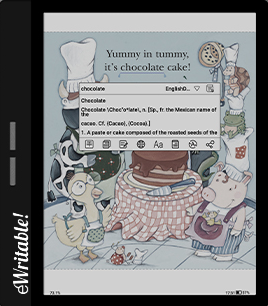Pros
- Budget-friendly
- Colour screen
- Great hardware specs
- Very versatile
- Handwriting search/conversion
- Google Play Store
- Frontlight
- Audio (speakers and microphone)
- MicroSD Card Slot
- Page turn buttons
Cons
- Smaller screen (not ideal for PDFs)
- Steeper learning curve
- Writing feels 'slippy'
- Screen is slightly darker than Monochrome e-ink tablets
- 'Clunky' firmware
A 7" colour e-ink writing tablet for less than $300 but the software is complex and clunky.
What follows is my initial review of the Bigme B751C e-ink tablet.
I’ve been using it regularly for nearly two weeks, however, it has been a manic fortnight for me and I’ve been unable to explore the features as much as I would have liked. So, I do intend to come back and update this review with more details at a future date.
Transparency Notice: This unit was sent to me for free by Bigme for review purposes. The fact that I received it for free will not alter my thoughts and opinions about it and I’m not being paid to write favourably about it. However, it is important that I am transparent about the circumstances under which I obtained the tablet.
As I stated in my unboxing and first impressions, I was rather intrigued by Bigme’s 7″ colour e-ink write tablet.
The price point of around $300 makes it much more affordable than any other colour e-ink tablet on the market (except the MobiScribe Wave Colour in some localities).
And it also offers some amazing specs for this price bracket; 2.3GHz processor, 4Gb RAM, 64Gb storage, speakers, microphone, MicroSD card slot etc.
But to provide such great specs at an affordable price, there have been some concessions elsewhere. The most notable is Bigme’s choice to forgo the usual Wacom EMR layer used for writing in favour of a capacitive layer instead. Not only does this mean that the stylus needs a separate power source (an AAAA battery) but the writing experience is not quite as good – there’s a noticeable latency, there’s very little friction on the screen, the stylus feels quite top-heavy and uncomfortable to hold, and it powers itself off if unused for a while.
Bigme have also cut costs by using a 7″ Kaleido 3 screen – the smallest on the market. Whilst this does mean that there is not a great deal of canvas area to write on (compared to other products), it does mean that it has a smaller form factor – more like an e-reader than a writing tablet.
The Bigme firmware as a whole feels quite clunky. Whilst I have little doubt that it is incredibly powerful and feature-rich, it is so unintuitive to use that it takes a long time to work out how to do something. Consequently, the learning curve is very steep.
It feels as though Bigme has made a list of all the features that the top e-ink tablets offer and just thrown them into their products without any consideration of user experience. There is also very little consistency between apps and the operating system, which can make operation confusing at times. In addition, a lot of the notifications and advisory messages have been poorly translated into English, so they don’t really help you to understand what you’re supposed to do.
Overall, it feels very much like a prototype firmware than something that should have been released on the market. I must admit that when I was playing around with the Bigme, I had flashbacks to my review of the Meebook P78 Pro over a year ago. Similarly, the Meebook also boasted decent specs at a knockdown price but was let down by its software implementation. In fact, I wouldn’t be surprised if Bigme were responsible for manufacturing the Meebook because of the similarities (Bigme works with many other brands as an Original Design Manufacturer – ODM).
Despite these criticisms, you can’t get any other colour e-reader with writing capabilities for less than $300 (except the MobiScribe Wave Colour) and the Bigme B751C trumps the MobiScribe in almost every area (except that the MobiScribe is waterproof and has a slightly bigger screen).
The hardware is great and it even has physical page-turn buttons. Although I’ve been knocking the consistency, intuitiveness, and user interface of the software, it does (on the whole) work well – it is absolutely fine for reading books and comics and taking basic notes. But if you want to make use of more advanced features, it is likely to be time-consuming and frustrating.
Because of the Android operating system, it is also possible to install 3rd-party apps from the Google Play Store, such as a web browser or social media apps. Which means that it has the potential to be more than just an e-reader/writer.
Bigme also ship their devices preinstalled with some other apps that have great potential. There’s a ChatGPT interface (which, admittedly, just feels as though they’re jumping on the AI bandwagon), a meeting notes app, and Global Handwriting (which allows you to write on the screen in any app). However, like the other software, they’re not particularly intuitive or user-friendly, so I’ve not yet had time to explore them as deeply as I would like. The Global Handwriting looks very interesting but I haven’t yet had the time to discover exactly how it works.
Final Verdict
I hope you’ll forgive me for publishing only a brief review.
As I said at the beginning, other priorities have completely screwed up my schedule over the last few weeks, and along with the complexity of the Bigme software, I simply haven’t had the time to be as thorough as I would have liked. However, I will return to this soon.
In the meantime, my overall verdict on the Bigme 751C tablet is that it is great from a hardware and price perspective (other than the capacitive stylus, which keeps powering off, much to my chagrin). But the software is quite difficult to use. It feels like a case of trying to throw as many features as possible into the firmware and see what sticks, with no overall framework to maintain consistency or enhance user experience. It’s as if every single feature was implemented by a completely different developer!
But, on the whole, the software does work pretty well – the native reading software is particularly nice. And once you teach yourself how to do something (or read the user manual, which has actually been written in far better English than the firmware messages), it is usable.
Bigme are a large and long-standing company and since they shifted from their role in the background as an ODM and began promoting their own brand, they have released several updates to their firmware. For me, it is not yet at a standard that I would describe as “great” but they are working on it and maybe this year they will enhance it to the stage whereby it will compete with the likes of Boox or Supernote. However, to do this, I think they need to start with the basics and build slowly from the ground up, rather than rapidly throwing even more features into the mix. I think a quality-over-quantity approach would serve them well.
Click here to buy the Bigme B751C
About the author
Dan Dutton is passionate about E-ink writing tablets, which bring together the pleasure of writing on paper with the power of digital technology. When he bought his first tablet, he realised that there wasn't a lot of unbiased information available for people that were considering buying an E-ink tablet, and so he built eWritable.


